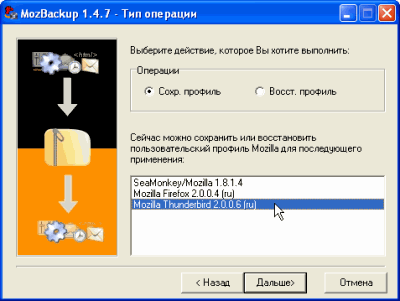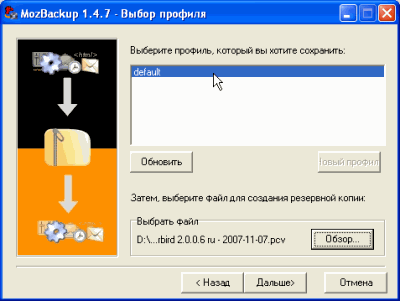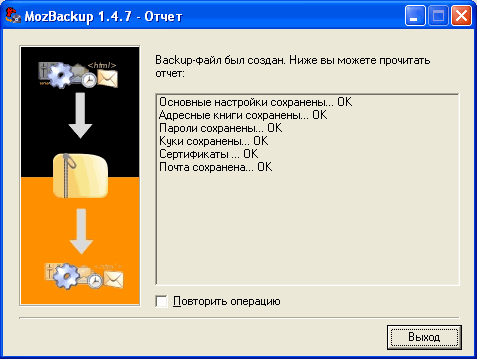Thunderbird резервное копирование. Архивация и восстановление профиля Thunderbird
Резервное копирование профиля
Чтобы сделать резервную копию вашего профиля необходимо закрыть Thunderbird и скопировать папку, содержащую ваш профиль, в другое место.
Закройте Thunderbird.
Определите расположение папки с вашим профилем, так как показано выше.
Перейдите в папку уровнем выше с папками ваших профилей %APPDATA%\Mozilla\Thunderbird\Profiles\
Щёлкните правой кнопкой мыши по папке содержащей ваш профиль (например xxxxxxxx.default) и выберите Копировать.
Щёлкните правой кнопкой мыши там, где вы хотите разместить резервную копию (например USB-накопитель или пустой CD-RW диск), и выберите Вставить.
Восстановление профиля из резервной копии
Закройте Thunderbird.
Если папка вашего текущего профиля и папка резервной копии профиля называются одинаково, то просто замените её папкой с резервной копией профиля, затем запустите Thunderbird.
Важно: Имена папок содержащих профиль должны совпадать, включая строку из 8 случайных символов. Если имена не совпадают или если вы восстанавливаете резервную копию в другое место, то следуйте инструкциям описанным ниже.
Восстановление резервной копии в другое место
Если имена папок с профилями не совпадают или вы хотите переместить или восстановить профиль в другое место, просто сделайте следующее:
Полностью закройте Thunderbird.
Используйте Менеджер Профилей Thunderbird, чтобы создать новый профиль в желаемом месте. Чтобы запустить Менеджер Профилей Thunderbird выполните
C:\Program Files\Mozilla Thunderbird\thunderbird.exe -P.
Заметка: Если вы просто установили Thunderbird на новый компьютер то вы можете использовать стандартный профиль, который автоматически создается, когда вы в первый раз запускаете Thunderbird.
Выйдите из Менеджера Профилей Thunderbird.
Найдите резервную копию профиля на жестком диске или на другом резервном носителе (например USB-накопителе).
Откройте папку резервной копии профиля (например, резервная копия xxxxxxxx.default).
Скопируйте целиком содержимое папки резервной копии профиля: файлы mimeTypes.rdf, prefs.js, папку bookmarkbackups и другие.
Найдите и перейдите в папку нового профиля, как показано выше, и закройте Thunderbird (если он запущен).
Вставьте содержимое папки резервной копии профиля в новую папку профиля, перезаписывая существующие файлы с одинаковыми именами.
Запустите Thunderbird.
Перемещение профиля
Иногда вам может захотеться перенести ваш профиль или указать Thunderbird использовать профиль, хранящийся в другом месте.
Закройте Thunderbird.
Переместите папку с профилем в желаемое место. например на Windows XP переместите профиль из C:\Documents and Settings\\Application Data\Thunderbird\Profiles\xxxxxxxx.default в D:\Stuff\MyMailProfile. (Если вы восстанавливаете резервную копию профиля, то в этом шаге нет необходимости. Просто запомните текущее расположение профиля, который вы желаете восстановить.)
Откройте файл profiles.ini в текстовом редакторе. Этот файл расположен в папке с данными приложения Thunderbird:
На Windows 7/Vista/XP/2000 путь %AppData%\Thunderbird\
На Windows 95/98/Me путь обычно C:\WINDOWS\Application Data\Thunderbird\
На Linux путь ~/.thunderbird/
На Mac OS X путь ~/Library/Thunderbird/
В файле profiles.ini найдите строчку с профилем, который вы только что переместили. Впишите в параметр Path= новое расположение профиля.
Если вы переключаетесь с относительного пути на абсолютный, то может потребоваться изменить наклон слешей. Например, в Windows, не относительные пути (абсолютные) используют слеши с левым наклоном, относительные же пути используют слеши с правым наклоном. Измените IsRelative=1 на IsRelative=0.
Сохраните profiles.ini и перезапустите Thunderbird.
Thunderbird saves personal information such as messages, passwords and user preferences in a set of files called a "profile", which is stored in a separate location from the Thunderbird program files. While it is possible to have multiple profiles, most users just use the single default (see Using Multiple Profiles for more information).
Table of Contents
What is a profile?
In Thunderbird, the profile stores two main sets of items. First, it stores your local mail, and possibly copies of messages that reside on the mail server (depending on your account configuration). Second, it stores any changes you make while using Thunderbird (for example, changes to account settings and changes to the toolbar).
When you install Thunderbird it creates a profile called "default". This profile will be used automatically unless you invoke the Profile Manager and create a new profile.
Where is my profile stored?
Profile files are stored separately from the Thunderbird program files. The program files are static and do not change (except when you upgrade the Thunderbird application version). Because we store profile and program files separately, you can uninstall Thunderbird without losing your messages and settings, and if something goes wrong with a Thunderbird update your information will still be available. It also means that you don"t have to reinstall Thunderbird in order to delete your information or troubleshoot a problem.
Each profile is stored on your hard drive in a profile folder. The folder is named using the following convention:
Where " %APPDATA%\Thunderbird\Profiles\xxxxxxxx.default\
~/Library/Thunderbird/Profiles/xxxxxxxx.default/
~/.thunderbird/xxxxxxxx.default/
Thunderbird stores your profile folder in this location on your computer, by default: To back up your profile, first close Thunderbird if it is open and then copy the profile folder to another location. Important:
The profile folder names must match exactly for this to work, including the random string of 8 characters. If the names do not match or if you are restoring a backup to a different location, follow the steps below. If the profile folder names do not match or if you want to move or restore a profile to a different location, do the following: Note:
If you just installed Thunderbird on a new computer, you can use the default profile that is automatically created when you first run Thunderbird, instead of creating a new profile. Occasionally, you might want to move a profile or tell Thunderbird to use a profile stored in another location. Heathy пишет:
Подскажите пожалуйста, можно ли (и каким образом) в Thunderbird скопировать все сохраненные письма и настройки, чтобы перенести на другой компьютер? Softbloger отвечает:)
Есть для этого специальная бесплатная программа от чешского программиста Pavel Cvrcek (даже не представляю как прочитать фамилию) - , которая позволяет создавать резервные копии для профилей программ семейства Mozilla (MozSuite/SeaMonkey, Mozilla Firefox, Mozilla Thunderbird
) и Netscape
. MozBackup делает копии почты, закладок, адресных книг, паролей и т.д. MozBackup поддерживает работу со следующими версиями программ:
Firefox 1.0 - 3.0 Alpha 6 Работает программа только под Windows (98/ME/NT/2000/XP/2003/Vista). Краткая инструкция по созданию бекапа настроек и данных Mozilla Thunderbird (работа с другими поддерживаемыми программами аналогична): 1. Скачайте, установите и запустите MozBackup: 3. Следуя подсказкам выбираем профиль и место на жестком диске компьютера куда будет сохранен файл бекапа. Жмем “Дальше”: 4. Здесь MozBackup спрашивает нас, не хотим ли мы защитить файл с данными паролем: Определяемся и переходим в следующее окно: Здесь нужно выбрать компоненты которые нужно сохранить. Лучше оставить все как есть. Идем “Дальше”. 5. Вот и все. Промелькнут строчки отчета и файл сохранится в указанной выше директории: Если вы хотите создать бекап для другой программы, поставьте галочку возле надписи “Повторить операцию” и нажмите “Дальше”. Восстановление данных программ происходит аналогичным образом. Скачать последнюю версию русской версии MozBackup можно а белорусской . P.S
(23.11.2007) Бэкап почтовых сообщений – это способ защиты вашей почты от потери. А при возникновении несчастного случая с вашим почтовым клиентом или компьютером, вы за 1 клик восстановите всю почту. Mozilla
Thunderbird
- популярный почтовый
клиент, на котором остановили свой выбор многие пользователи электронной почты.
Однако проблема потери почтовых сообщений не избежала и их. Дело в том, что ни
одна почтовая программа, за исключением высокопрофессиональных, не может
похвастаться наличием в своем интерфейсе такой немаловажной функции как
резервное копирование почты. Таким образом, как и всем прочим пользователям электронной
почты, пользователям Mozilla
Thunderbird
приходится искать решение для резервного
копирования почтовых
сообщений и другой информации, хранящейся в их почтовом клиенте. Если и вы
столкнулись с подобной проблемой, то спешим вас обрадовать: на сегодняшний день
существует масса простых и надежных решений для копирования популярных почтовых
клиентов, в том числе и почты Mozilla
Thunderbird
. http
://www
.handybackup
.ru
/email
-backup
.shtml
Для того чтобы выбрать оптимальное решение, стоит
поподробнее рассмотреть функционал программ резервного копирования почты.
Начнем, конечно, с функции выбора почтового клиента. Программа резервного
копирования почты должна поддерживать функцию копирования Mozilla
Thunderbird
, только тогда она
вам действительно подходит. То есть важно уточнить, как именно бэкап-программа
работает с данным конкретным почтовым клиентом. В идеале программа должна иметь
отдельный пресет для резервного копирования Mozilla
Thunderbird
. Это значит, что пользователю достаточно просто выбрать в
меню программы опцию резервного копирования Mozilla
Thunderbird
и все данные этого почтового
клиента будут автоматически зарезервированы, включая сообщения, адреса,
контакты, календари, настройки все прочее. Кроме того, программа резервного копирования почты Mozilla
Thunderbird
должна уметь
делать архивацию и шифрование резервных копий Mozilla
Thunderbird
, ведь вы не
хотите потерять самую ценную информацию в процессе ее сохранения на носители
или транспортировки на удаленный сервер. Вопрос сохранения резервных копий тоже не маловажен. От
того, где вы будете хранить резервные копии Mozilla
Thunderbird
, в конечном счете, зависит
целостность данных, ведь в случае их потери данные придется восстанавливать и
тут все зависит от надежности вашей программы для бэкапа Mozilla
Thunderbird
и от качества
носителя. Во многих случая уместно сохранять резервные копии Mozilla
Thunderbird
на удаленные FTP
сервера
или удаленные компьютеры по сети. Хотя копирование на оптические диски такие
какCD
, DVD
, HD
DVD
, Blu
-ray
- также хороший способ. Главное не копировать резервные копии
Mozilla
Thunderbird
на локальный жесткий диск, иначе бэкап теряет всяческий смысл. Что касается самого процесса копирования почты Mozilla
Thunderbird
, то проводить ее
следует регулярно по заранее заданному расписанию. Только такое копирование
может гарантировать, что ни одно сообщение не будет потеряно в результате
поломки жесткого диска или другой неприятности. Хорошая программа резервного
копирования имеет гибкий планировщик задач с возможностью запуска задачи
резервного копирования почты Mozilla
Thunderbird
каждый день, неделю, месяц и многие другие функции. Thunderbird saves personal information such as messages, passwords and user preferences in a set of files called a "profile", which is stored in a separate location from the Thunderbird program files. While it is possible to have multiple profiles, most users just use the single default (see Using Multiple Profiles for more information). In Thunderbird, the profile stores two main sets of items. First, it stores your local mail, and possibly copies of messages that reside on the mail server (depending on your account configuration). Second, it stores any changes you make while using Thunderbird (for example, changes to account settings and changes to the toolbar). When you install Thunderbird it creates a profile called "default". This profile will be used automatically unless you invoke the Profile Manager and create a new profile. Profile files are stored separately from the Thunderbird program files. The program files are static and do not change (except when you upgrade the Thunderbird application version). Because we store profile and program files separately, you can uninstall Thunderbird without losing your messages and settings, and if something goes wrong with a Thunderbird update your information will still be available. It also means that you don"t have to reinstall Thunderbird in order to delete your information or troubleshoot a problem. Each profile is stored on your hard drive in a profile folder. The folder is named using the following convention: Where " %APPDATA%\Thunderbird\Profiles\xxxxxxxx.default\
~/Library/Thunderbird/Profiles/xxxxxxxx.default/
~/.thunderbird/xxxxxxxx.default/
Thunderbird stores your profile folder in this location on your computer, by default: To back up your profile, first close Thunderbird if it is open and then copy the profile folder to another location. Important:
The profile folder names must match exactly for this to work, including the random string of 8 characters. If the names do not match or if you are restoring a backup to a different location, follow the steps below. If the profile folder names do not match or if you want to move or restore a profile to a different location, do the following: Note:
If you just installed Thunderbird on a new computer, you can use the default profile that is automatically created when you first run Thunderbird, instead of creating a new profile. Occasionally, you might want to move a profile or tell Thunderbird to use a profile stored in another location.Profile Location Summary
How to find your profile
Finding your profile without opening Thunderbird
C:\Users\
Windows hides the AppData
folder by default, but you can find your profile folder as follows:
without pressing Enter. A list of profile folders will appear.
%APPDATA%\Thunderbird\Profiles\
without pressing Enter. A list of profiles will appear at the top of the Start menu.Backing up a profile
Restoring a profile backup
Restoring to a different location
Moving a profile
- Thunderbird 1.0 - 2.0
- SeaMonkey 1.0a - 1.1
- Mozilla Suite 1.7 - 1.7.x
- Netscape 7.x.




Подумал я вот сегодня - если есть русский и белорусский переводы MozBackup, то наверно должен быть и украинский. Подумал, подумал а потом взял да и перевел выложенныйTable of Contents
What is a profile?
Where is my profile stored?
Profile Location Summary
How to find your profile
Finding your profile without opening Thunderbird
C:\Users\
Windows hides the AppData
folder by default, but you can find your profile folder as follows:
without pressing Enter. A list of profile folders will appear.
%APPDATA%\Thunderbird\Profiles\
without pressing Enter. A list of profiles will appear at the top of the Start menu.Backing up a profile
Restoring a profile backup
Restoring to a different location
Moving a profile